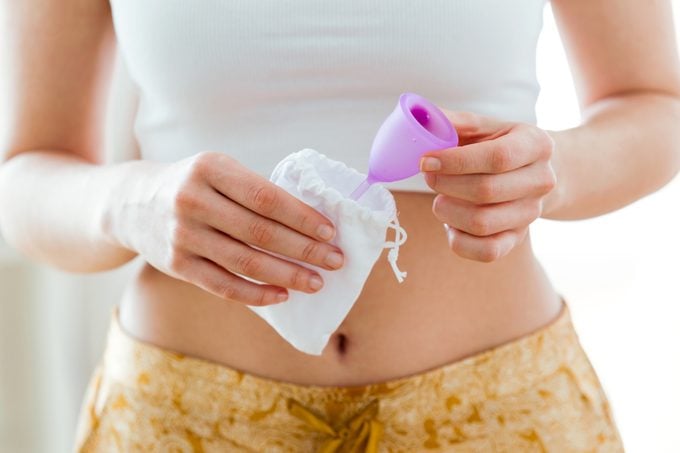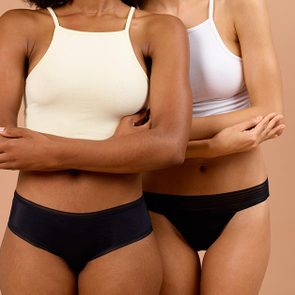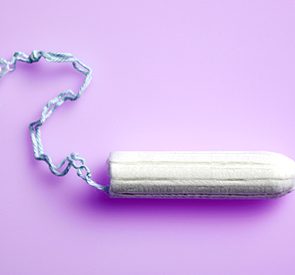What to Know About Menstrual Cups, Including How to Use One
Updated: Aug. 18, 2021
How do menstrual cups work? Here's what you need to know about using period or menstrual cups instead of tampons or pads.
What is a menstrual cup?
If you’re tired of tampons or pads, the idea of a reusable and easy-to-use alternative might sound too good to be true. The reality is it exists—and it’s called a menstrual cup.
This reusable feminine hygiene product resembles a small funnel. The silicone or rubber material makes it easily foldable to go into the vagina and collect period blood.
Although there are disposable options, most cups are reusable like period underwear. And the word is out about their newfound popularity. Most people think of the popular menstrual cup brand DivaCup, but now there are even more options.
So, how do menstrual cups work? Here’s what experts want you to know. Plus, everything else you need to know about using one.

How to use a menstrual cup
If you’re wondering how to insert a menstrual cup, Marco Mouanness, MD, OB-GYN, and fertility expert at Rejuvenating Fertility Center shares some step-by-step tips.
- Start with finding a comfortable position. Sitting on the toilet, standing, or squatting are popular options.
- Tightly fold the cup in your hand in half, holding it in one hand with the rim facing up.
- Next, insert the cup, rim up, into your vagina. It shouldn’t be painful when you insert it.
- Menstrual cups should be inserted at a 45-degree angle to coincide with the angle of the vagina, notes Sandy Dorcelus, DO, an OB-GYN at NYU Langone Hospital in New York.
- To do this, hold the folded menstrual cup with one hand, use your free hand to part your labia. Locate your vaginal opening, and slowly insert your menstrual cup into your vagina in the direction of your tailbone.
“If you’re in doubt, reach in and feel around the base of the cup, it should feel round or oval and not have any noticeable folds,” Dr. Mouanness says.
How to empty a menstrual cup
Always start with cleaning your hands.
Next, use your index finger and thumb to pinch the base of the cup to gently remove it.
Then empty the cup and rinse it.
How to avoid menstrual cup leaks
People who want to avoid leaks from the cup need to make sure they insert it correctly, and not too low in the vagina.
“The most common cause of leakage from [a] menstrual cup is abnormal insertion, mainly because it didn’t completely unfold,” Dr. Mouanness says.
Leakage is also possible if you have a heavy menstrual flow or clogged pressure holes on the sides of the cup, he notes. If you wear the wrong size or the cup is full, it may also leak, according to Dr. Dorcelus.
Do you need to remove it for penetrative sex?
Dr. Dorcelus says the majority of cups need to be removed before intercourse.
Intimina does make a reusable cup that can be worn during sex.
Dr. Mouanness says you don’t need to remove it, but it is preferable to do so.
“Most partners won’t feel it, [but] some might,” he says. “If it gets pushed back too deep, it might be a bit difficult to remove.”
So, what do you do if you think the menstrual cup is stuck?
Take a break from trying to remove the cup, then try again, advises Dr. Dorcelus.
If your menstrual cup is stuck, the first maneuver to do is to bear down and put pressure on your pelvic muscle to try to lower it down and dislodge it, according to Dr. Mouanness.
Another option is to firmly squeeze the body of the cup between your finger and thumb (several times) to try to break the rim’s seal and then gently pull it outwards.
The third option, if the above doesn’t work, is to run your finger up to the rim and press inwards to allow air between the cup’s rim and the surface it has suctioned onto, then pull out gently, Dr. Mouanness says.
“If that still doesn’t work, we recommend for you to check with your physician,” he says. “You do not want to keep it lodged in there for too long as it may cause infections.”
(Here are other common period mistakes.)
How to clean a menstrual cup
The cup comes with a set of cleaning instructions.
Generally, prior to reusing a menstrual cup, you need to wash and wipe it clean. Some menstrual cup brands specifically sell wipes or washes for these cups.
You could also use an oil-free, unscented soap instead.
Another cleaning recommendation is to sterilize your cup in-between each cycle by boiling it in water for five to ten minutes. Most cups come with a storage bag.
Reasons to try a menstrual cup and potential benefits
Dr. Mouanness says that one of the main benefits is that menstrual cups collect blood, rather than absorb it like tampons or pads.
Because period cups are not absorbent, the risk of toxic shock syndrome (TSS) is lower. A meta-analysis of 43 studies including 3,319 women that was published in The Lancet Public Health found only five reported cases of TSS in people using menstrual cups.
TSS is a relatively rare but serious condition caused by a bacterial infection, and it’s associated with improper tampon use. This research suggests menstrual cups are a safer alternative.
Plus, the cup holds more blood than a tampon, Dr. Mouanness adds. People typically only need to empty the cup twice a day, which is another perk, according to Dr. Dorcelus.
Many people like menstrual cups because they are eco-friendly and, depending on the brand, reusable. Not only is this better for the environment, but it’s also easier on your budget.
Research published in Canadian Family Physician found that, out of 110 women, 90 percent of women would recommend a period cup to a friend.
Are there any risks?
Besides the fact that removal and insertion could be messy or uncomfortable, menstrual cups may cause irritation or increase the risk of infection.
However, people can avoid this downside if they clean the cup properly and always wash their hands before and after every use.
Talk to your doctor if you see the following signs of infection including:
- unusual vaginal discharge or odor
- vaginal pain or soreness
- burning or pain during urination or intercourse
IUDs
Another potential risk is for people with an IUD. Some claim using a menstrual cup could dislodge this birth control device. Yet, most experts say it’s safe.
One study on 930 women in Contraception found no evidence that women who report using menstrual cups or tampons for menstrual protection had higher rates of early IUD expulsion.
Still, more research is necessary and always check your IUD when you take out a period cup.
Next, check out the habits that mess with vaginal health.





















